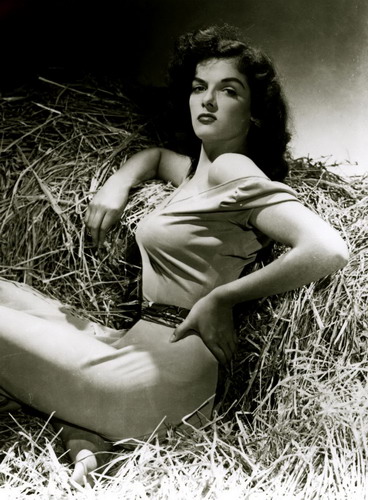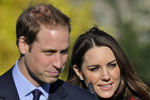Newsmaker
Jane Russell, star of '40s and '50s films, dies
Updated: 2011-03-01 15:32
(Agencies)
|
 Actress Jane Russell arrives at the premiere of the film "xXx: State of the Union" in Los Angeles in this April 25, 2005 file photo. [Photo/Agencies]
|
| ||||
"She always said I'm going to die in the saddle, I'm not going to sit at home and become an old woman," Waterfield told The Associated Press. "And that's exactly what she did, she died in the saddle."
Hughes, the eccentric billionaire, put her onto the path to stardom when he cast her in "The Outlaw," a film he fought with censors for nearly a decade to get into wide release.
With her sultry look and glowing sexuality, Russell became a star before she was ever seen by a wide movie audience. The Hughes publicity mill ground out photos of the beauty in low-cut costumes and swim suits, and she became famous, especially as a pinup for World War II GIs.
Then in 1948 she starred opposite Bob Hope in the box-office hit, "The Paleface," a comedy-western in which Russell was tough-but-sexy Calamity Jane to Hope's cowardly dentist.
Although her look and her hourglass figure made her the subject of numerous nightclub jokes, unlike Marilyn Monroe, Rita Hayworth and other pinup queens of the era, Russell was untouched by scandal in her personal life. During her Hollywood career she was married to star UCLA and pro football quarterback Bob Waterfield.
"The Outlaw," although it established her reputation, was beset with trouble from the beginning. Director Howard Hawks, one of Hollywood's most eminent and autocratic filmmakers, rankled under producer Hughes' constant suggestions and finally walked out.
"Hughes directed the whole picture- for nine bloody months!" Russell said in 1999.
The film's rambling, fictional plot featured Russell as a friend of Billy the Kid as he tussles with Doc Holliday and Sheriff Pat Garrett.
It had scattered brief runs in the 1940s, earning scathing reviews. The Los Angeles Times called it "one of the weirdest Western pictures that ever unreeled before the public."
But Hughes made sure no one overlooked his No 1 star. The designer of the famous "Spruce Goose" airplane used his engineering skills to make Russell a special bra (which she said she never wore) and he bought the ailing RKO film studio to turn it into a vehicle for her.
Wisely, he also loaned her to Paramount to make "The Paleface," because at RKO she starred in a series of potboilers such as "His Kind of Woman" (with Robert Mitchum), "Double Dynamite" (Frank Sinatra, Groucho Marx), "The Las Vegas Story" (Victor Mature) and "Macao" (Mitchum again).
Hughes had rewarded her with a unique 20-year contract paying $1,000 a week, then he sold RKO and quit making movies. Russell continued receiving the weekly fee, but never made another film for Hughes.
Her only other notable film was "Gentlemen Prefer Blondes," a 1953 musical based on the novel by Anita Loos. She and Monroe teamed up to sing "Two Little Girls From Little Rock" and seek romance in Paris.
At a 2001 film festival appearance, Russell noted that Monroe was five years younger, saying, "It was like working with a little sister."
She followed that up with the 1954 musical "The French Line," which like "Gentlemen Prefer Blondes" had her cavorting on an ocean liner. The film was shot in 3-D, and the promotional campaign for it proclaimed "J.R. in 3D. Need we say more?"
In 1955, she made the sequel "Gentlemen Marry Brunettes" (without Monroe) and starred in the Westerns "The Tall Men," with Clark Gable, and "Foxfire," with Jeff Chandler. But by the 1960s, her film career had faded.
"Why did I quit movies?" she remarked in 1999. "Because I was getting too old! You couldn't go on acting in those years if you were an actress over 30."
She continued to appear in nightclubs, television and musical theater, including a stint on Broadway in Stephen Sondheim's "Company." She formed a singing group with Connie Haines and Beryl Davis, and they made records of gospel songs.
For many years she served as TV spokeswoman for Playtex bras, and in the 1980s she made a few guest appearances in the TV series "The Yellow Rose."
She was born Ernestine Jane Geraldine Russell on June 21, 1921, in Bemidji, Minnesota, and the family later moved to the San Fernando Valley in Los Angeles. Her mother was a lay preacher, and she encouraged the family to build a chapel in their back yard.
Despite her mother's Christian preachings, young Jane had a wild side. She wrote in her 1985 autobiography, "My Paths and Detours," that during high school she had a back-alley abortion, which may have rendered her unable to bear children.
Her early ambition was to design clothes and houses, but that was postponed until her later years. While working as a receptionist, she was spotted by a movie agent who submitted her photos to Hughes, and she was summoned for a test with Hawks, who was to direct "The Outlaw."
"There were a lot of other unknowns who were being tested that day," she recalled in a 1999 Associated Press interview. "I figured Jack Beutel was going to be chosen to play Billy the Kid, so I insisted on being tested with him."
Both were cast, and three months would pass before she met Hughes. The producer was famous for dating his discoveries as well as numerous Hollywood actresses, but his contract with Russell remained strictly business. Her engagement and 1943 marriage to Waterfield assured that.
She was the leader of the Hollywood Christian Group, a cluster of film people who gathered for Bible study and good works. After experiencing problems in adopting her three children, she founded World Adoption International Agency, which has helped facilitate adoptions of more than 40,000 children from overseas.
She made hundreds of appearances for WAIF and served on the board for 40 years.
As she related in "My Path and Detours," her life was marked by heartache. Her 24-year marriage to Waterfield ended in bitter divorce in 1968. They had adopted two boys and a girl.
That year she married actor Roger Barrett; three months later he died of a heart attack. In 1978 she married developer John Peoples, and they lived in Sedona, Arizona, and later, Santa Barbara. He died in 1999 of heart failure.
Over the years Russell was also beset by alcoholism.
Always she was able to rebound from troubles by relying on lessons she learned from her Bible-preaching mother.
"Without faith, I never would have made it," she commented a few months after her third husband's death. "I don't know how people can survive all the disasters in their lives if they don't have any faith, if they don't know the Lord loves them and cares about them and has another plan."
Survivors include her children, Thomas K. Waterfield, Tracy Foundas and Robert "Buck" Waterfield, six grandchildren and 10 great-grandchildren.
A public funeral is scheduled March 12 at Pacific Christian Church in Santa Maria.
In lieu of flowers the family asks that donations be made in her name to either the Care Net Pregnancy and Resource Center of Santa Maria or the Court Appointed Special Advocates of Santa Barbara County.
|
 Actress Jane Russell is shown in this publicity photograph for the 1943 film "The Outlaw" released to Reuters on Feb 28, 2011. [Photo/Agencies]
|
E-paper

Lingua franca
Chinese are learning English on a scale never seen before and the business of teaching is booming.
Preview of the coming issue
Golden run ahead
Looking abroad
Specials

NPC & CPPCC sessions
Lawmakers and political advisers gather in Beijing to discuss major issues.

Sentimental journey
Prince William and Kate Middleton returned to the place where they met and fell in love.

Rent your own island
Zhejiang Province charts plans to lease coastal islands for private investments



